Original German WWII Excellent Condition Army Heer M35 Single Decal Helmet with 56cm Liner – ET64 Original Items
$ 1.495,00 $ 373,75
Original Item: Only One Available. This is an excellent all original example of a German WWII M35 helmet, issued to the Heer (Army). The condition leads us to believe that it was used very little during WWII, if at all. The helmet was scrutinized from front to back, and everything we can see about it is correct.
This stamped sheet steel construction helmet retains almost all of its original Feldgrau paint, with just some minor scuffs and areas of rust keeping it from being mint. The left side of the helmet features an original Heer eagle decal, which is retained 95+%, with with a tiny chip missing and age toning.
The reverse, interior, neck guard apron is batch number stamped 3441, and the interior, left side, apron has a stamped manufacturer’s code and size, ET64 indicating that indicating it was manufactured by Eisenhuttenwerk AG, Thale Harz, Germany in size 64. Size 64 is a nice medium size that can accommodate liners from 56cm to 57cm or US 7 to 7 1/8. Size 64 shells are harder to find and are therefore more valuable to a collector.
All three liner retaining pins are intact, with original paint fully intact. They also have markings stamped onto the “legs”. The interior of the helmet still has the original M31 leather liner with all eight of it’s fingers intact. The liner is ink stamped with a size 56 in a circle, with the original size adjustment string. There is also the correct felt padding under the liner, which is marked 64 n.A / 56 on the outside of the early issue aluminum band. The chinstrap is not present, most likely removed at some point to put on another helmet. However the liner has the correct 1931-1940 style square aluminum bales.
The aluminum liner band is also is maker marked, though we cannot make out all of the circular maker marking without removing the liner, which we did not do. We can see enough however to know it reads:
Metall-Lederverarbeitung W.Z.
1939
Bln.- Ch’burg 5
This indicates production by the metal and leather working company Werner Zahn, based in Berlin – Charlottenburg, in the year 1939, exactly what we would expect based on the style of the liner.
Overall this is an excellent example of a German “Single Decal” M35 helmet. It does not appear to have been repainted or messed with in any way. The shell does not appear to have been stripped or sandblasted, and there is definitely only one coat of paint on it. Everything we can see about it is RIGHT. This is an item that will only continue to appreciate in value over time.
The first “modern” steel helmets were introduced by the French army in early 1915 and were shortly followed by the British army later that year. With plans on the drawing board, experimental helmets in the field, (“Gaede” helmet), and some captured French and British helmets the German army began tests for their own steel helmet at the Kummersdorf Proving Grounds in November, and in the field in December 1915. An acceptable pattern was developed and approved and production began at Eisen-und Hüttenwerke, AG Thale/Harz, (Iron and Foundry Works), in the spring of 1916.
These first modern M16 helmets evolved into the M18 helmets by the end of WWI. The M16 and M18 helmets remained in usage through-out the Weimar Reichswehr, (National Defence Force, Circa 1919-1933), era and on into the early years of the Third Reich until the development of the smaller, lighter M35 style helmet in June 1935.
In 1934 tests began on an improved Stahlhelm, whose design was a development of World War I models. The Eisenhüttenwerke company of Thale carried out prototype design and testing, with Dr. Friedrich Schwerd once again taking a hand.
The new helmet was pressed from sheets of molybdenum steel in several stages. The size of the flared visor and skirt was reduced, and the large projecting lugs for the obsolete armor shield were eliminated. The ventilator holes were retained, but were set in smaller hollow rivets mounted to the helmet’s shell. The edges of the shell were rolled over, creating a smooth edge along the helmet. Finally, a completely new leather suspension, or liner, was incorporated that greatly improved the helmet’s safety, adjustability, and comfort for each wearer. These improvements made the new M1935 helmet lighter, more compact, and more comfortable to wear than the previous designs.
The Army’s Supreme Command officially accepted the new helmet on June 25, 1935 and it was intended to replace all other helmets in service.
More than 1 million M1935 helmets were manufactured in the first two years after its introduction, and millions more were produced until 1940 when the basic design and production methods were changed to reduce production time. This mainly included having the vent hole being stamped directly into the shell, as opposed to being riveted on later.
Fast Shipping with Professional Packaging
Thanks to our longstanding association with UPS FedEx DHL, and other major international carriers, we are able to provide a range of shipping options. Our warehouse staff is expertly trained and will wrap your products according to our exact and precise specifications. Prior to shipping, your goods will be thoroughly examined and securely secured. We ship to thousands clients each day across multiple countries. This shows how we're dedicated to be the largest retailer on the internet. Warehouses and distribution centres can be located throughout Europe as well as the USA.
Note: Orders with more than one item will be assigned a processing date depending on the item.
Before shipping before shipping, we'll conduct a thorough inspection of the items you have ordered. Today, the majority of orders will be delivered within 48 hours. The delivery time will be between 3-7 days.
Returns
The stock is dynamic and we cannot completely manage it because multiple stakeholders are involved, including our factory and warehouse. So the actual stock may alter at any time. It's possible that you may not receive your order once the order has been made.
Our policy is valid for a period of 30 days. If you don't receive the product within 30 days, we are not able to issue a refund or an exchange.
You can only return an item if it is unused and in the same state as the day you received it. You must have the item in its original packaging.
Related products
Uncategorized
Uncategorized
Uncategorized
Uncategorized
Uncategorized
Angolan Rebel 1970s era 60mm Inert Display Mortar from Angolan Civil War Original Items
Uncategorized
Uncategorized
Uncategorized
Uncategorized
Uncategorized
Uncategorized
Uncategorized
Uncategorized
Uncategorized
Uncategorized
Australian WWII Owen MK1 Machine Carbine SMG Custom Fabricated Replica with Sling Original Items
Uncategorized
Uncategorized
Uncategorized
Uncategorized













































































